By Michele L. – Cornwall Master Gardener
This article appeared in the February Issue of the Gardening in Orange County Newsletter. Click here to subscribe!
![Photo by (c) 2006 Derek Ramsey (Ram-Man). Co-attribution - Chanticleer Garden. [CC BY-SA 3.0 (http://creativecommons.org/licenses/by-sa/3.0/)], from Wikimedia Commons Aeonium arboreum 'Zwartkopf'](https://blogs.cornell.edu/master-gardeners-cce-oc/files/2019/01/Aeonium-arboreum-Zwartkopf-1k523kl-300x254.jpg)
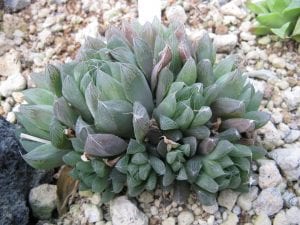
![Frank Vincentz [GFDL (http://www.gnu.org/copyleft/fdl.html) or CC-BY-SA-3.0 (http://creativecommons.org/licenses/by-sa/3.0/)], from Wikimedia Commons](https://blogs.cornell.edu/master-gardeners-cce-oc/files/2019/01/Kalanchoe_eriophylla_02_ies-25v976e-300x263.jpg)
I am frequently asked how to keep succulents alive since there are thousands of different succulent cultivars, all growing with different care requirements and sizes.
![Emmanuelm at English Wikipedia [CC BY 3.0 (https://creativecommons.org/licenses/by/3.0)]](https://blogs.cornell.edu/master-gardeners-cce-oc/files/2019/01/Crassula_bonsai-22f5pwe-256x300.jpg)
Treat your succulent garden as living art. Don’t be afraid to pull out a plant that has overgrown the planter or has died. Just replace with another succulent. Succulents are a great gift for a non-gardener. Decorate with flowers, berries, shells, or pinecones to theme up your succulent containers or vertical gardens. You can just pull out flowers once they have wilted or brown out and still have a beautiful creative piece.
OUTDOOR DO’S AND DON’TS
Containers
The best pot/container for a succulent is a shallow terra cotta or clay pot with a large drainage hole. The deeper the container, the more susceptible the plant is to rotting from wet soil. A 13-inch or smaller shallow garden dish is the perfect container and can hold a nice selection of succulents. This type of container is shallow enough that it won’t become waterlogged if left outside in the rain all summer. If you have created a vertical garden (one that hangs on the wall), keep it flat for at least one month until the roots have established themselves. Once the succulents have rooted you can hang it on wall.
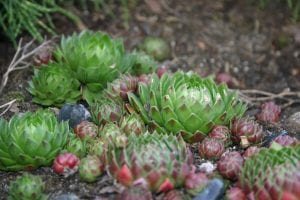
Some of my many favorite succulents are Echeveria, Sempervivum, Sedums, Haworthia and Kalanchoe. Move outdoors early to mid-June. Most succulents can tolerate night temps of 50 degrees. Some varieties of Sempervivum and Sedums are cold-hardy and can survive our harsh winters.
![Daderot [Public domain], from Wikimedia Commons Sedum ruspestre 'Angelina'](https://blogs.cornell.edu/master-gardeners-cce-oc/files/2019/01/Sedum-rupestre-Angelina-on-a-rock-wall-slwnzo-e1547837668654-300x260.jpg)
Winter/cold hardy Sedums are best for this type of planting as they have shallow root systems and spread easily. My favorite is a sedum called Angelina which has beautiful yellow flowers, and some varieties change leaf colors from green to gold in the fall.
Water
Overwatering is the main reason succulents die. The key to watering is restraint! Remember they are filled with water. They are the camels of the plant world. If the leaves are plump, don’t water. If they look slightly shriveled or puckered it is time to water. Rain water is preferable to tap water. Water-softened tap is not recommended because of excessive salt content.
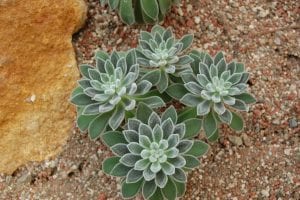
Succulents like bright light, but most cannot tolerate intense, direct sunlight outdoors all day. Morning or late afternoon sun is ideal. Most succulents need only 3 to 4 hours of sun a day. Never place in a southern exposure outdoors. The intensity of the light that a plant prefers depends on the species. Keep in mind that succulents have very different growing habits, some grow very slowly and others will double in size in a season.
While optimal lighting conditions depend on species, there are some general signs that indicate your plant is getting either too much or too little light:
Too much light: appears “off color,” “bleached out”, or turning yellow. Your plant can scorch on a dark wall in full sun and will likely not recover.
Too little light: stretches out and appears leggy and will weaken plant.
INDOORS – YEAR ROUND OR OVER WINTERING
Light
If your succulents were outside, place them in the sunniest location in your home in winter. Best indoor location is an east, west or south windowsill. I also have a number of my succulents indoors under lights. I have 2 types of lights – the typical white grow- lights are fine, but I prefer the red and blue spectrum grow-lights specifically for succulents.
Water
When your succulent garden is very dry, water it thoroughly. Every one or two weeks should be sufficient indoors depending on time of year. Succulents should be given just enough water so that they show no sign of shriveling.
PESTS
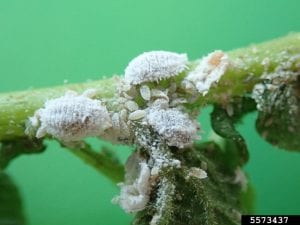
Mealybugs
These soft oval insects shroud themselves in a cottony covering. The presence of these cotton masses indicates infestation. Mealybugs dine on plant sap reducing plant vigor, distorting growth, and causing premature leaf shed. Minor infestations can be handled by dabbing the offending individuals with an alcohol soaked cotton swab. The alcohol dissolves their waxy protective coating leaving them susceptible to desiccation and other environmental stressors.
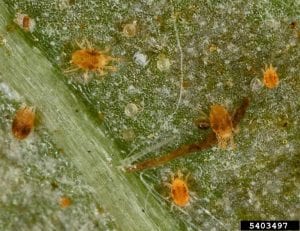
Spider Mites
Spider mites are all but invisible to the unaided eye. These pests are often found on the underside of leaves shrouded in their whitish webs. Spider mites also dine on plant sap and cause a distinctive stippling pattern on infested leaves. Copious amounts of webbing indicate a large infestation, which means drastic measures must be taken such as removing all infested leaves. If the infestation is minor a strong burst of overhead watering can help eliminate the mites. Mites are not insects, so insecticides are ineffective.
Scale
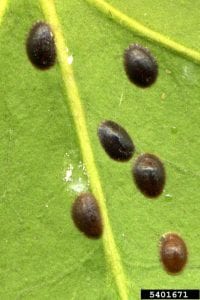
These pinhead-sized insects appear as raised brown spots resembling marine shells. Like many other pests, they dine on the plant’s sap. Outbreaks of scale can be treated similarly to mealybug infestations.
FERTILIZER
During the growing season, a balanced fertilizer (10-10-10), which has been diluted to 1/4 strength, can be added to the water for each watering; or use specific fertilizer (foam) for succulents. Only use fertilizers on soil and not on the plant itself. My favorite is worm castings which will not burn the succulents and seem to cut down on pest infestations as well.
PROPAGATION
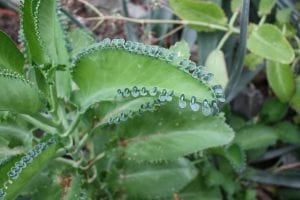
Sometimes it is very easy to identify the best way to propagate your succulents and other times it is not as obvious. However, before you start, the first thing to ask yourself is: What kind of plant do I have? If you don’t know, the easiest way to learn is to organize the information you know about your plant into categories. How is it shaped? Is it tall and thin, short and round? How does it grow? Does it grow all by itself, or are there similar tiny plants that poke up out of the soil near it?
Questions like these are the first ones to ask yourself when considering propagation. Some species can be propagated by separating pups from around the base of the plant. With others you can start a new plant by just placing one of the leaves on top of soil. If succulents start stretching and getting leggy, try pinching off the top, let dry out for a few days to callus over the end and then replant.
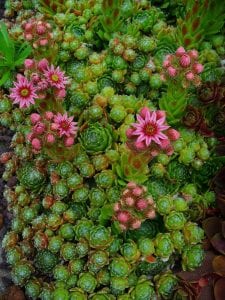
Monocarpic is, in fact, a strategy of many plants to produce progeny. Most monocarpic succulents produce many new plants before they bloom. So by the time they are ready for the bloom, they’ve already created enough plants to replace themselves.
